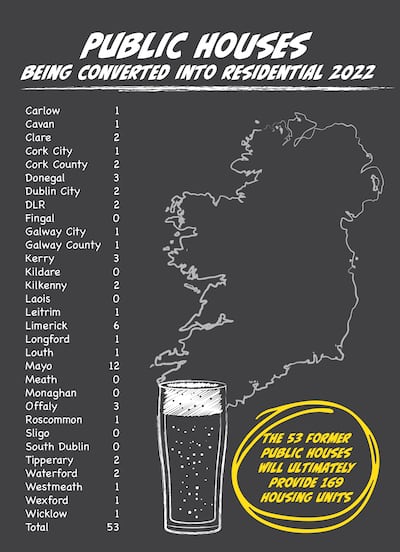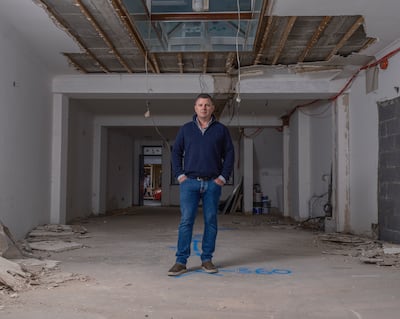There is little surprise that Co Mayo has attracted the largest number of applications to transform former pubs into homes under a Government scheme, introduced last year by Minister for Housing Darragh O’Brien, to provide much-needed homes.
Twelve of the 53 successful applicants across 24 local authority areas, over a 10-month period, are from Mayo.
Despite the fact that figures show one-quarter of its public houses have closed since 2005, a 2018 AIB survey confirmed Mayo had the most pubs per capita in the country, with one for every 323 people in the county.
In addition, the founder of the vacant homes project, Tom Gilligan, is a Mayo County Council executive and a passionate advocate of urban regeneration.
READ MORE

[ More than 50 pubs apply for conversion to homes without planning permissionOpens in new window ]
As a result, one-time pubs in towns from Charlestown to Ballyhaunis, Westport and Ballinrobe, Swinford and Kiltimagh, are now set to become homes. A key factor is that such developments are exempt from the planning process and thus their completion can be fast-tracked.
Castlebar is set to benefit from three such projects. There was a time when every second property on the county town’s Linenhall Street was a family-run licensed premises.
When local developer Kieran Staunton, who runs Castlecarra Developments with his cousin David Staunton, purchased The Hazel Inn at an auction in 2017, he planned to reopen it as a traditional-style pub while refurbishing the four first-floor apartments. His mother, Margaret, had worked in several of the old-style pubs around the town over the years, so for Kieran, a native of the nearby village of Carnacon, this was a nod of respect to her and the legacy of small pubs.
“The premises was trading as Flannerys until 1993 when it was bought and substantially rebuilt, with the new owner renaming it The Hazel Inn two years later when it reopened,” Kieran says, adding that “it was a thriving business” until the impact of the Celtic Tiger crash took its toll and it closed in 2007.

“We really wanted to reopen it as a nice, cosy traditional pub because of my mother’s history of working in some of the pubs on that street. But when we tried to find someone to manage it, we couldn’t find anyone. We also tried to identify options for developing it for other retail outlets or services. Then Covid hit and everything was on hold,” he says.
When O’Brien introduced the scheme last year, the cousins “felt sad that they had to let go of their pub idea” but knew its provisions were too attractive to ignore, with a ground-floor space lying empty and still unused. They had already refurbished the four upstairs apartments and rented them to tenants.
With the imminent redevelopment of the ground floor, the Stauntons are delighted now to be adding to the vibrancy of this historic street with two new apartments. The one-time pub is just a few doors from where one of the lords, Lucan, built the original Linen Hall in 1790. The building is now a widely-used arts centre.
“If we had to go through the usual planning process, it would be much more timely and costly and, in the end, it could have been refused. We could have ended with our application before An Bord Pleanála and it could have [been] given a thumbs down for all sorts of reasons,” he says.
Despite the fact that the property will no longer be one of the town’s public houses, its traditional facade will be maintained, as is required by the scheme, and the building will now be called The Hazel Inn Apartments.












